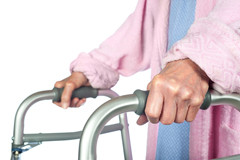Harvard Health Blog
Two questions can reveal mobility problems in seniors

The hottest trend in mobility right now is not a smart phone or wireless gadget. The mobility that's making health headlines is the kind that lets us do what we need to do: walk and move. Mobility is essential for getting through the day, whether you need to walk across a room to the bathroom or kitchen, get out of bed or a chair, or walk through a grocery store.
Loss of mobility, which is common among older adults, has profound social, psychological, and physical consequences. "If you're unable to get out then you can't go shopping, you can't go out with your friends to eat dinner or go to the movies, and you become dependent on other people to get you places. So you become a recluse, you stay home, you get depressed. With immobilization comes incontinence, because you can't get to the bathroom, you can develop urinary infections, skin infections. The list goes on," says geriatrician Dr. Suzanne Salamon, an instructor at Harvard Medical School.
The cascade of negative effects that comes with immobility can often be prevented or limited, according to a review in today's JAMA. Researchers from the University of Alabama at Birmingham looked at dozens of mobility studies published over the years. They discovered common factors that lead to loss of mobility, such as older age, low physical activity, obesity, impaired strength and balance, and chronic diseases such as diabetes and arthritis. Less common red flags included symptoms of depression, problems with memory or thinking skills, being female, a recent hospitalization, drinking alcohol or smoking, and having feelings of helplessness. Individuals with one or more of these factors is at risk for immobility.
Given that so many things that can lead to immobility, you'd think primary care physicians would be able to spot older adults at risk of losing mobility. But it's not so simple, says Dr. Salamon. "There are so many other things that doctors have to pay attention to—heart problems and lung problems—that screening for mobility gets pushed to the background. However, it's one of the most important, because it makes the difference between living at home or living in a facility," she explains. She also points out that loss of mobility puts you at greater risk for falling, which often results in a hip fracture. "That's the worst, because within a year 20% of people with hip fractures die from complications. So we try to avoid that at all costs," says Dr. Salamon.
Checking a person's mobility is fairly simple. Dr. Salamon likes the Get Up and Go Test, where she asks a person to stand up from sitting in a chair, walk 10 feet, turn around, walk back to the chair, and sit down. "You look at how long that takes and how steady the person is," she says. Another way is just to watch how quickly people walk. They should walk faster than a yard per second. If you walk that or faster, you're normal; if you're slower, you have a gait problem, which increases your chances of falling," she says.
The University of Alabama researchers suggest asking these two questions:
- For health or physical reasons, do you have difficulty climbing up 10 steps or walking one-quarter of a mile?
- Because of underlying health or physical reasons, have you modified the way you climb 10 steps or walk a quarter of a mile?
The beauty of the "test" is that you don't have to go to a doctor to get an answer. You probably know already if you're having trouble climbing stairs. And walking one-quarter of a mile? That's one lap around a medium-sized mall's upper level. Can you walk around it without difficulty?
If stairs and walking are difficult, it's an indication that you're on the road to less travel, and you'll need to see your doctor. The good news is that your physician can help you address what's causing the difficulty before it progresses to a loss of mobility. A variety of solutions are available. They can include physical therapy to improve balance and strength training. Occupational therapy can help improve a person's ability to perform daily living activities and the living environment with tools such as elevated bathroom fixtures and grab bars. Social support can help eliminate mobility barriers such as lack of transportation. Referrals to subspecialists may be needed to treat medical conditions that can lead to immobility. Finally, the use of devices such as canes, walkers, wheelchairs, and scooters can open the door to greater mobility.
There are a few tools you can check out online, including the Get Up and Go test as well as the Performance-Oriented Mobility Assessment. Take the test with a friend or loved one who can help you if needed; don't try it at home if you're unsteady on your feet.
Loss of mobility is a real problem, but one that is often preventable or treatable. Take steps now to make sure you can take the steps you need in the years ahead.
Disclaimer:
As a service to our readers, Harvard Health Publishing provides access to our library of archived content. Please note the date of last review or update on all articles.
No content on this site, regardless of date, should ever be used as a substitute for direct medical advice from your doctor or other qualified clinician.












